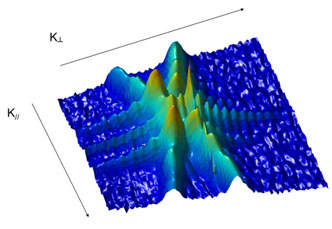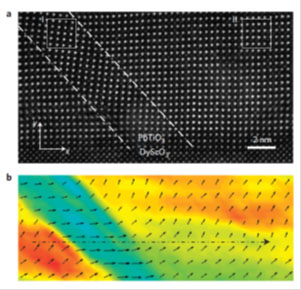Publicatie in Nature Materials: Ultradunne piëzo-elektrische materialen om energie te winnen
Piëzo-elektrische materialen produceren elektrische spanning als ze worden ingedrukt. Op dit moment worden ze toegepast in gasaanstekers, inkjet-printers, trillingsdempers en apparaten die gebruik maken van ultrasoon geluid. Maar piëzo-elektrische materialen hebben ook de potentie om te worden toegepast voor het winnen van elektriciteit uit trillingen van auto’s, huishoudelijke apparaten en industriële machines.
Een onderzoeksteam onder leiding van de Groningse hoogleraar prof. dr. Beatriz Noheda publiceert deze week in Nature Materials een artikel over een methode om nieuwe, breder toepasbare piëzo-elektrische materialen te maken.
Verloren energie terugwinnen
Met piëzo-elektrische materialen kunnen trillingen die overal voorkomen, omgezet worden in elektriciteit. Een enorme hoeveelheid energie die nu verloren gaat, zou zo benut kunnen worden. De toekomstdroom van Noheda en haar team is dat straten, spoorwegen en vloeren geplaveid zijn met piëzo-elektrische materialen. Maar voor het zover is, moeten die materialen eerst lichter, dunner en minder giftig worden (de huidige piëzo-elektrische materialen bevatten veel zware elementen). Het onderzoek dat Noheda en haar team uitvoerde, zet een flinke stap in die richting.
Flexo-elektriciteit
Het onderzoek in Nature Materials laat zien, dat de piëzo-elektrische materialen als ze onder bepaalde, zorgvuldig gekozen condities worden neergeslagen in ultra-dunne films (met een dikte van ongeveer honderd atoomlagen), een zelf-organiserende structuur krijgen die samentrekt en uitrekt in een regelmatig patroon. De grote vervormingsgradiënt die zo wordt verkregen, maakt een nieuw mechanisme mogelijk om piëzo-elektriciteit op te wekken, de zogenaamde flexo-elektriciteit. Dit vergroot de respons bij deze geringe materiaaldiktes aanzienlijk. Bovendien is deze nieuwe productiemethode minder afhankelijk van de samenstelling. Dat opent de weg naar onderzoek naar het gebruik van minder giftige en beter verkrijgbare materialen voor het winnen van piëzo-elektrische energie.
Het team van Beatriz Noheda was samengesteld uit onderzoekers van het Zernike Institute for Advanced Materials van de Rijksuniversiteit Groningen, het Mesa+ Instituut van de Universiteit Twente, het CIN2-Barcelona en de CEMES-CNRS Instituten in Toulouse en Zaragoza.
Prof.dr. Beatriz Noheda is adjunct-hoogleraar Functional Nanomaterials en Rosalind Franklin Fellow. In 2004 ontving zij een Vidi-beurs van NWO.
Referentie: Flexoelectric rotation of polarization in ferroelectric thin films, G. Catalan, A. Lubk, A. H. G. Vlooswijk, E. Snoeck, C. Magen, A. Janssens, G. Rispens, G. Rijnders, D. H. A. Blank en B. Noheda. Nature Materials.
DOI: http://dx.doi.org/10.1038/NMAT3141


Meer nieuws
-
11 december 2025
Stormachtige planeten en een onverwachtse atmosfeer
-
09 december 2025
Faculty of Impact Grant voor nieuwe behandeling hersenkanker
